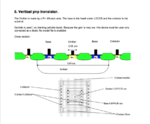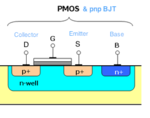vadim888
Member level 2
Hi all,
I am designing a bandgap, and I have a question. I want to find a proper ration for these resistors, and have no idea how to star...

from that paper:
In the paper from Banba,
"A CMOS bandgap reference circuit with sub-1-V operation"
**broken link removed**
there is just "find an optimal ratio" :-|.
Any idea how to start resistor sizing?
Because all equation is just for output Vref.
PS also I am open for any decent tutorials, primers and whatsoever examples regarding Bandgap Voltage reference design.
I am designing a bandgap, and I have a question. I want to find a proper ration for these resistors, and have no idea how to star...

from that paper:
In the paper from Banba,
"A CMOS bandgap reference circuit with sub-1-V operation"
**broken link removed**
there is just "find an optimal ratio" :-|.
Any idea how to start resistor sizing?
Because all equation is just for output Vref.
PS also I am open for any decent tutorials, primers and whatsoever examples regarding Bandgap Voltage reference design.

